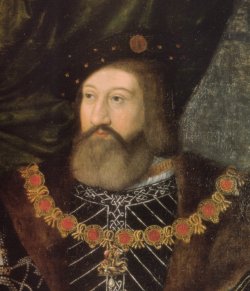
Charles Brandon, 1st Duke of Suffolk
Born: c. 1484
Died: August 22, 1545
Guilford, Surrey, England (Age c. 61)
Suffolk in History
When one looks at the history of the Brandon family, it will not seem surprising that Charles Brandon became a leading figure within the Tudor dynasty. Charles's father, William, was killed at the Battle of Bosworth Field (1485) while bearing the standard of the soon-to-be King Henry VII, while Charles was only a year old, and his uncle Thomas was one of Henry VII's most trusted advisers throughout the entirety of his reign. The younger Brandon also began his rise to power by acting as a serving boy in the king's presence and performing a number of other minor, yet important, tasks. During this time, Charles built up a friendship with Prince Henry (heir to the throne since his elder brother's death in 1502), despite the fact that Charles was the prince's senior by about seven years, that would last until the former's death.
When the prince ascended the throne as Henry VIII in 1509, Charles was easily the new king's favorite. He was made marshal of the king's household; master of the horse; a Knight of the Garter; and Viscount Lisle, all by 1513. Charles also participated in the king's French expedition that same year and proved to be, at the very least, a competent and capable military commander. For his services, Charles was given the great honor of being created Duke of Suffolk the year after the expedition. There were many members of the nobility that did not look highly on this, but when one was as popular with Henry VIII as Charles was, it mattered not. However, the new duke temporarily fell out of favor with the king when he secretly married Henry's sister Mary, whose husband, Louis XII of France, had recently died. It was not Suffolk's first marriage, as between the years of 1503 and 1510, he had engaged in no less than two suspicious marriages which resulted in the birth of several children, in addition to the duke's illegitimate offspring from his mistresses.
Suffolk was ultimately returned to the king's favor but was hurt financially, being forced to surrender several of his offices, as well as a large portion of Mary's dowry. Despite the animosity between the two men, Suffolk continued to be looked upon as one of Henry VIII's favorites and frequently jousted with him and took part in politics. Suffolk's political sway was not as high as it once was since the rise of Cardinal Thomas Wolsey and others, such as the Duke of Norfolk and the Boleyn family. But when Wolsey fell out of favor in 1529 (he died after being arrested for treason the following year) and the collapse of the Boleyn family (the king had taken Anne Boleyn as his second wife) in1536, it was Suffolk who showed he had the real staying power.
However, Suffolk was also facing a number of personal issues. His wife Mary died in 1533, and the duke realized that he had married off his elder daughters to some less than reputable gentlemen, which ended up costing him a lot of money. Suffolk, however, was able to maintain his place at court and actually worked somewhat well with the king's new top adviser, Thomas Cromwell. The same year as Mary's death, Suffolk married the fourteen-year-old Katherine Willoughby, a fairly wealthy heiress which helped secure him financially. In 1536, the duke played a role in the suppression of the Pilgrimage of Grace and in the Scottish and French expedition of the 1540s, while attending the Privy Council more than ever. Suffolk was a very flexible man when it came to politics because he remained ambiguous on the topic of religion (though he seemed to lean towards the orthodox faith) and could therefore work well with both conservatives and reformists. It was Suffolk's political flexibility and his unwavering loyalty to the crown that made his sudden death in 1545 a crushing blow to Henry VIII and his kingdom. The king, now without the greatest friend he ever had, would follow the duke to his grave less than two years later.
Suffolk in Shakespeare
Appears in: Henry VIII
The Duke of Suffolk appears in Henry VIII as one of the magnates, along with the Duke of Norfolk and the Earl of Surrey, whose goal is to expose the dishonest deeds of Cardinal Wolsey, which the lords are ultimately successful in doing. In addition to the character of Suffolk, there is a character that appears briefly (to arrest the Duke of Buckingham in the play's opening scene) named Brandon. Since Suffolk's name was Charles Brandon, it has been suggested that they are the same person. This, however, is all speculation and remains a mystery to this day.
References
Gunn, S. J. ‘Brandon, Charles, first duke of Suffolk (c.1484–1545)’, Oxford Dictionary of National Biography, Oxford University Press, Sept 2004; online edn, Oct 2009 [http://www.oxforddnb.com/view/article/3260, accessed 27 April 2010]